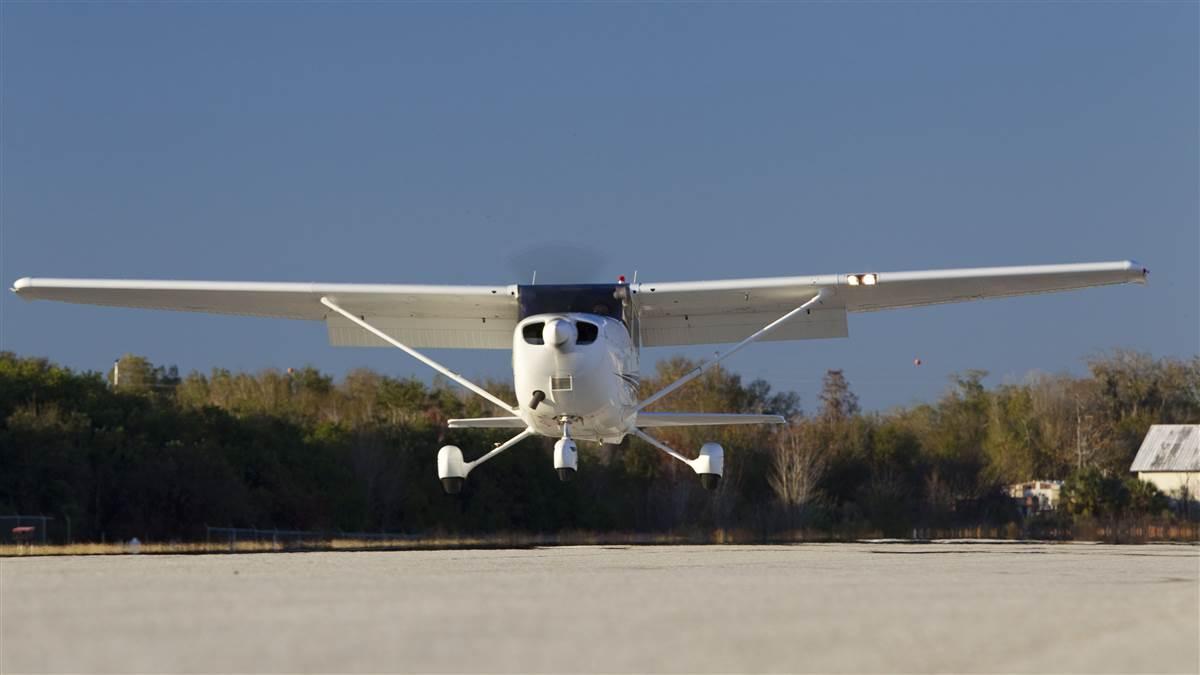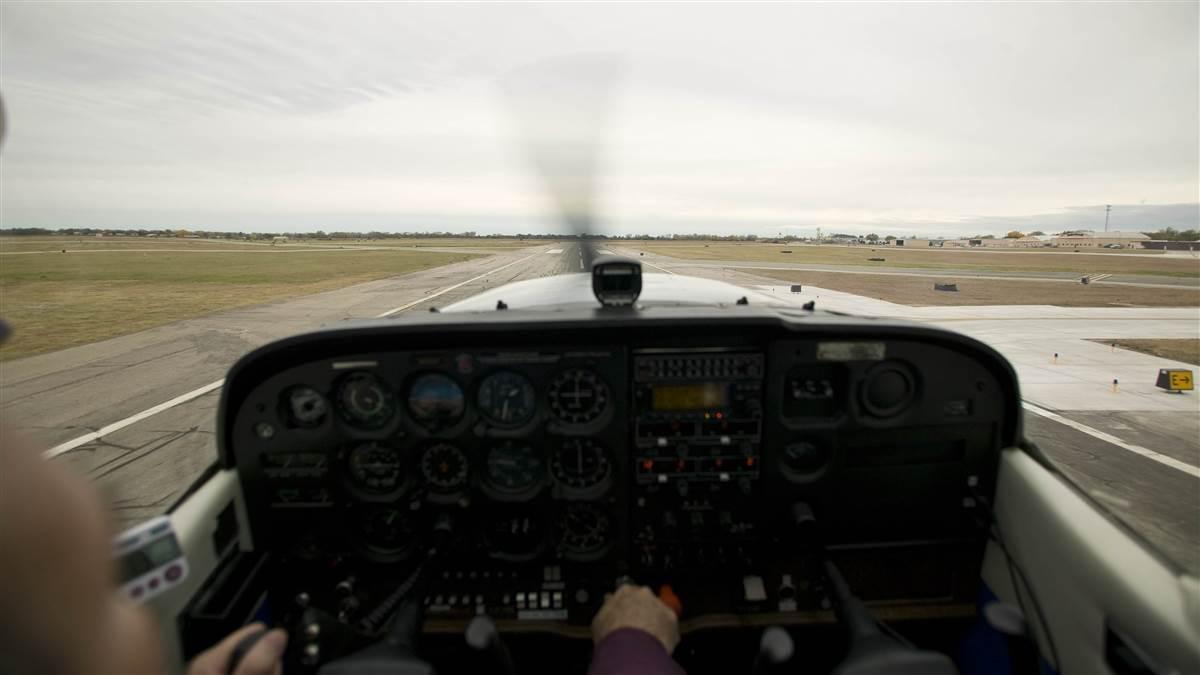Landing With Flair
For a perfect touchdown, slow down—slowly

The FAA’s Airplane Flying Handbook describes the flare as “a slow, smooth transition from a normal approach attitude to a landing attitude, gradually rounding out the flightpath to one that is parallel with, and within a very few inches of, the runway.” Applying back-pressure to the yoke slowly raises the airplane’s nose and increases its angle of attack. The steeper angle between the wings and the relative wind increases lift, and the airplane’s descent slows as airspeed bleeds off. The wings approach their critical angle of attack in the flare and, ideally, stop flying just after the main wheels touch the surface.
How does a student learn to coordinate that transition at just the right speed and height above the runway? Practice, practice, practice. But flying an entire lap around the pattern for another three-second chance at perfection can be demoralizing for a budget-conscious student. If you struggle with timing the flare, you may be trying to do too much, too fast. Techniques that simplify the landing process and give you more time to focus on the flare may help you overcome this common training hurdle.
“We call it the presolo slump,” said Bob Hepp, 2016 National CFI of the Year and owner of Virginia flight school Aviation Adventures. “Why does it take so long to learn to land? The reason, I think, is because the landing is a combination of all the things that you were working toward at that point. It’s slow flight, it’s stall, it’s a ground reference maneuver. You’re changing altitudes and speed. The big difference is at altitude.”
At altitude, students practice in a nonthreatening environment, Hepp said. As students shift their focus from maneuvers to landings, they enter a high-pressure environment close to the ground. Slowing down—both by prolonging the flare and by reducing distractions that give students less time to focus—helps this new skill “click.” Hepp said training practices that do just that have helped cut the time to solo at his school’s three locations to a third of what it used to be.
“When I was taught to fly, and most other people were taught to fly, you come in and you level off two to three feet off the runway, and then you hold it off until the airplane gets into a pitch attitude that it’s ready to sink,” said Hepp. “Unless your airspeed is right on target, if you come in with a little bit of excess airspeed, then when you level off like that—now you’re in ground effect. It puts you in that two to three feet above the runway for a long time.”
When an airplane floats in ground effect, the temptation is to force the nosewheel onto the ground. Then, the mains hit and the airplane bounces back in the air. The sequence continues in a series of pilot-induced oscillations called a porpoise. “It’s not the first touch that takes the nosewheel off the airplane, it’s the second or third,” Hepp said.
Instead, instructors at Aviation Adventures teach students to bring the nose up to level about 10 feet above the runway. “Whatever speed you were coming in at—on speed, fast, or slow—the airplane will hold that attitude until it reaches a predetermined speed,” Hepp said. “If you’ve got the pitch level, you’re always going to be at the same speed about five feet above the runway.” That leaves a student consistently in the same place, with more vertical room to work with, Hepp said. At five feet, the student can start slowly pulling the yoke back to continue the flare.
Many instructors feel so strongly about this two-part landing technique that they use different terms to describe the level-off and the continuation of the flare. Although the FAA uses the terms roundout and flare interchangeably, some instructors see these as distinct parts of the landing sequence. In his How to Fly an Airplane Handbook, Rod Machado explains why he uses two terms instead of one. “If you have more terms available to you to define specific and distinct events in reality, then you’re more capable of describing that reality to others,” he writes. In his view, the roundout and flare are two separate actions, and they deserve the vocabulary to reflect that.
 For the roundout, pull back to a level flight attitude about 10 feet above the runway. If you still have any power applied, pull the throttle back to idle at this point, too. These two actions cause the airspeed to decrease, and a normal 500-foot-per-minute descent slows to a gentler 100 to 200 feet per minute. Now the runway isn’t rising up to meet you so quickly, and you can focus on the next stage of the landing: the flare.
For the roundout, pull back to a level flight attitude about 10 feet above the runway. If you still have any power applied, pull the throttle back to idle at this point, too. These two actions cause the airspeed to decrease, and a normal 500-foot-per-minute descent slows to a gentler 100 to 200 feet per minute. Now the runway isn’t rising up to meet you so quickly, and you can focus on the next stage of the landing: the flare.
In this school of thought, the flare begins when the aircraft’s nose rises above level. This ensures that the airplane’s sturdier main gear will touch down first, and continues the airplane’s deceleration as it approaches the runway. “With power reduced to flight idle, you pull aft on the elevator to progressively raise the nose and reduce the airspeed while the airplane remains a foot or less above the ground,” writes Machado. As less air flows over the wings, you’ll need more back-pressure. The airplane will touch down about 150 feet past the aiming point you kept in the windscreen during final approach.
Although skilled pilots make landings that may seem like one fluid movement, chances are they’re making multiple adjustments in the flare, applying and relaxing back-pressure subtly to keep the airplane’s nosewheel off the ground. Don’t be afraid to adjust the back-pressure if you realize you’re flaring too aggressively or not enough—but do not push the elevator control forward to correct for an overaggressive flare. This can cause the airplane to strike the runway nosewheel first, and may damage the airframe. If you flared too hard, either gently relax elevator pressure or hold it constant, depending on how much correction is needed. You may need to advance the throttle slightly to keep the airplane from dropping too quickly or stalling. Or, take advantage of that always-available option: Go around.
The speed of the flare depends on the airplane’s height above the ground, rate of descent, and pitch attitude, so different configurations will affect the look and feel of the flare in your trainer. Because a full-flap approach results in a lower pitch attitude than a no-flap approach, the nose must travel through a greater pitch change to reach the proper landing attitude. With less distance to travel, the nose can rise more slowly in a no-flap landing.
Flying an entire lap around the pattern for another three-second chance at perfection can be demoralizing for a budget-conscious student.The 35 or so instructors at Aviation Adventures teach their students to fly power-off, no-flap landings before students attempt to land with flaps or power. This method has several advantages, Hepp said: It simplifies procedures so students don’t have to focus on changing configurations, sight pictures, and airspeeds; students better learn the relationship between pitch attitude and airspeed; instructors can demonstrate the forward slip; and it gives students early practice with the basics of emergency
power-off landings. When it comes to the flare, this type of landing practice gives students more time to get a feel for the transition.
A typical circuit around the pattern takes about six minutes, reasons Hepp. In a normal-flap landing, the flare takes about three or four seconds. Then it’s another six minutes around the pattern to try again. Without flaps, students have triple the time in the flare to understand what it feels and looks like. “The airplane’s more sensitive to pitch control, which makes it a little bit harder—but once you get it, landing with flaps is a piece of cake,” Hepp said.
Combined with Hepp’s roundout-flare technique, this training practice helps to slow things down, and meter the concepts and skills students are expected to process and develop at one time. “We’ve taken people that have learned to fly or started to learn at other places and very, very quickly—with those two techniques together—it’s like, ‘Oh, I get it,’” he said.

A typical trainer has an approach speed of about 65 knots, descending around 500 feet per minute. The roundout slows that descent to 100 to 200 feet per minute and allows the airspeed to decrease. By the time the main wheels touch the runway, the airplane is traveling nearly parallel to the runway and just above stall speed.
Illustration by Allan Davey
COMMON ERRORS IN THE FLARE
|
The problem Flaring too early/high With the runway approaching, often students instinctively pull aft. At 20 to 40 feet above the runway, this can slow the airplane too much, too early—and result in a hard landing, or even a stall. |
The problem Landing left of center Students assume that because they’re on the left side of the airplane, they should be on the left side of the center stripe. |
The problem Flaring too flat If the nose of the aircraft isn’t raised enough, the airplane can touch down nosewheel first. |
|
Fix it Recognizing the tendency will help you to counter it. If you do begin the flare too high, relax back-pressure on the yoke to continue the descent. Add a little power if needed. |
Fix it “Forget about your position in the airplane, just put the center stripe between your legs,” says CFI Bob Hepp. |
Fix it Raise the nose above the horizon with more back-pressure. |
|
The problem Flaring too late/low Waiting too late to start the roundout can bring too much speed into the flare and cause the airplane to float or balloon. If you push the nose down to compensate, you can porpoise or hit on the nosewheel. |
The problem Flaring too aggressively Pulling back with too much force, or coming in with too much speed—and not making the proper adjustments—can cause the aircraft to balloon. |
|
|
Fix it Use the roundout to slow your descent. |
Fix it Relax back-pressure and let the airplane settle back to a few feet above the runway. |




